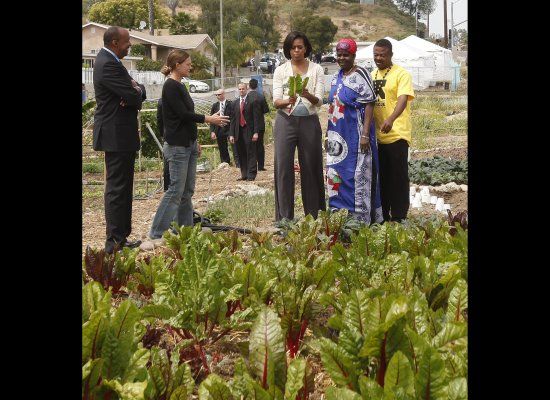Your tax dollars!
Michelle Obama on refugee gardening: “It’s a model for the nation, for the world”

A reporter once asked me how on earth could these refugee resettlement contractors and their spin-off groups make much money out of resettling refugees by the head when they receive a one time flat fee for each refugee planted in your town. I explained that most of the income for the contractors and subcontractors come through the myriad grants they receive through the Office of Refugee Resettlement for administering everything under the sun—job training programs, English classes, refugee savings accounts, micro-enterprise loan programs, healthy marriage training programs, and even refugee veggie growing projects like those described in an article at TakePart.
Knowing a bit about agriculture and how hard it is to make a profit (unless you are a corporate farm with millions invested in land and equipment) these feel-good gardening projects taxpayers pay for—you pay for!—can only survive with large infusions of federal cash.
From TakePart (hat tip: Joanne):
There are now agricultural programs across the country—many of which have been bolstered by federal Refugee Agricultural Partnership Program grants—aimed at transitioning people into their new lives in the States by focusing on the agrarian background shared by many refugees. But these garden plots are also meeting the demand for niche produce, such as bitter melon, providing a local market for vegetables that are staples in a refugee’s country of origin but are harder to find in the U.S. and are often sold for a premium.
After a discussion about Cleveland, reporter Sarah McColl takes us to one of our favorite locations for refugee resettlement—Nashville, Tennessee where we learn about an $85,000 grant that the Center for Refugees and Immigrants of Tennessee received from the federal government for FY14-FY16.
So how many veggies can you grow with $85,000 in federal funding!
Somali Community Center becomes Center for Refugees and Immigrants of Tennessee
Some longtime readers may remember that the Center was originally the Somali Community Center in Nashville. Let’s take a minute and go down memory lane. Here is what we said about the name change back in 2009:
So they conveniently dropped the name, Somali Community Center, eh? Could it be they want to shed their bad image with federal granting agencies? We have heard of this before, some agency or volag gets into grant trouble and pretty soon they are going by another name, I suppose hoping that new federal or state grantors (or the public!) won’t link them to the former bad acts.
A reminder to readers, the Somali Community Center got into hot water with the federal government over misuse of grants and with a possible connection to terrorist activities back in 2007. Check out this important and shocking story from Nashville’s Channel 4 news at the time.
The link to the shocking story is gone, but visit our post where we had, thank goodness, preserved the original text.
Back to the gardening grant where you can be sure the Center gets to keep a certain amount of your money for administrative purposes.
Snake gourds trellised up a willow tree? (and you paid for it!)

It’s much the same in Nashville: There are plenty of international grocery stores, explained Lauren Bailey, director of agricultural programs at the Center for Refugees and Immigrants of Tennessee. Access isn’t the problem.
“It’s less that they’re not able to find it and more that it’s expensive,” Bailey said. “But the crops that we’ve grown this year, they’ve been able to grow prolifically without spending a lot of money.” One enterprising gardener told Bailey he’d earned $25 from his mustard greens haul, though most take what they grow home to their own kitchen. “I sense that they’re excited to be growing, but also excited to be providing for their families,” she said.
In its first year after receiving a 2014 federal Refugee Agricultural Partnership Program grant, the Nashville program now includes a community garden, ESL instruction, and a training garden that hosts an 18-week market gardening course that’s regularly attended by refugees from Burma and Bhutan. It’s not a simple matter of the students learning from the teachers, however. “At one training garden they were growing a snake gourd, and they trellised it up a willow tree, and I’ve never seen anything like it before,” Bailey said.
Supplemental income, language practice, fresh veggies, and marketable skills are all important aspects of resettlement that are easier to quantify than some of the other benefits Bailey and Fitzpatrick have observed in the garden.
“It’s not just that it might provide income,” Bailey said, “but that it might bring health or improve their quality of life. For a lot of our gardeners, it’s a sense of ownership and pride—the work that they’re doing, and what they’re able to accomplish.”
Again, check out the whole list of grants for refugee gardens. By the way, I see that the now defunct Indiana gardens that American volunteers had to try to save (when refugees tired of the work) are no longer on the list.
Someone needs to take one of these grants, get the original grant requirement and track the federal money and figure out how much it costs to produce the veggies and what the return on your investment is, photograph the gardens on a regular basis and see how many refugees are actually gardening. I suspect there is lots and lots of room for fraud in managing one of these federal warm and fuzzy give-away programs.
